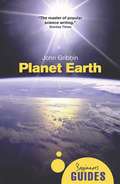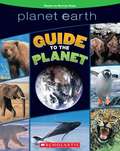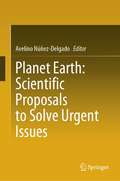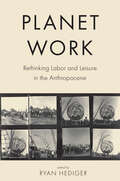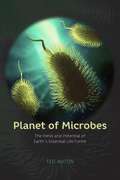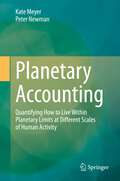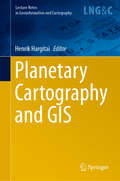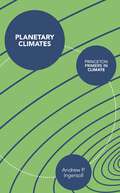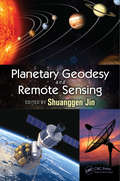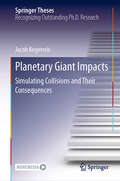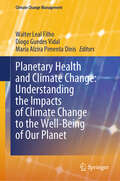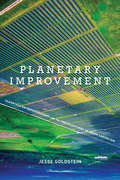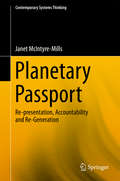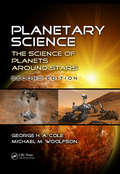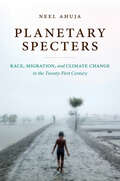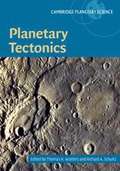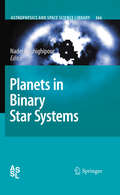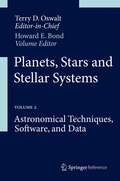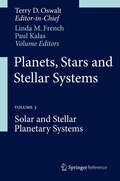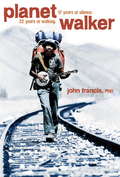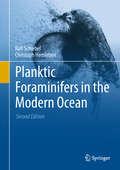- Table View
- List View
Planet Earth: A Beginner's Guide (Beginner's Guides)
by John GribbinIn this incredible expedition into the origins, workings, and evolution of our home planet, John Gribbin, bestselling author of In Search of Schrödinger's Cat, The Scientists, and In Search of the Multiverse, does what he does best: taking four and a half billion years of mind-boggling science and digging out the best bits. From the physics of Newton and the geology of Wegener, to the environmentalism of Lovelock, this is a must read for Earth's scientists and residents alike. Trained as an astrophysicist at Cambridge University, John Gribbin is currently Visiting Fellow in Astronomy at the University of Sussex, England.
Planet Earth: Guide To The Planet
by Steve MurrieAre you ready for the highest, lowest, hottest, coldest, darkest, brightest, wildest, and windiest locations on Earth? They're all here, along with the incredible animals that inhabit them. It's the official guide to your whole world.
Planet Earth: Scientific Proposals to Solve Urgent Issues
by Avelino Núñez-DelgadoThis book represents the most comprehensive overview of issues affecting our planet and the forefront solutions, including climate change, air, water, soil pollution, demography, and access to food and water. This edited book, led by Prof. Núñez-Delgado, counts with the participation of leading researchers across a wide range of disciplines to be an inspiring and motivating document to promote sustainability and biodiversity. Those of you asking for trustworthy analyses about sustainability and climate change and the vanguard solutions will find this book fascinating.
Planet Ocean
by Paul Watson Jan DutkiewiczVeteran environmental activist and Whale Wars host Paul Watson offers in this interview a provocative and revolutionary view of the state of an environment in crisis. The planet may survive our environmental destruction, he argues, but humans may not. Focused on protecting oceans, preventing the loss of biodiversity, and promoting individual action, Watson's singular call to arms challenges the typical talking points of the modern environmental movement.
Planet Work: Rethinking Labor and Leisure in the Anthropocene
by James Armstrong Jennifer K. Ladino Amanda Adams Ted Geier Sharon O'Dair Ryan Hediger David Rodland Sinan Akilli Daniel Clausen Matt Wanat Will Elliot Kevin Maier Jo ReyLabor and labor norms orient much of contemporary life, organizing our days and years and driving planetary environmental change. Yet, labor, as a foundational set of values and practices, has not been sufficiently interrogated in the context of the environmental humanities for its profound role in climate change and other crises. This collection of essays demonstrates the urgent need to rethink models and customs of labor and leisure in the Anthropocene. Recognizing the grave traumas and hazards plaguing planet Earth, contributors expose fundamental flaws in ideas of work and search for ways to redirect cultures toward more sustainable modes of life. These essays evaluate Anthropocene frames of interpretation, dramatize problems and potentials in regimes of labor, and explore leisure practices such as walking and storytelling as modes of recasting life, while a coda advocates reviving notions of work as craft.
Planet of Microbes: The Perils and Potential of Earth's Essential Life Forms
by Ted AntonWe live in a time of unprecedented scientific knowledge about the origins of life on Earth. But if we want to grasp the big picture, we have to start small—very small. That’s because the real heroes of the story of life on Earth are microbes, the tiny living organisms we cannot see with the naked eye. Microbes were Earth’s first lifeforms, early anaerobic inhabitants that created the air we breathe. Today they live, invisible and seemingly invincible, in every corner of the planet, from Yellowstone’s scalding hot springs to Antarctic mountaintops to inside our very bodies—more than a hundred trillion of them. Don’t be alarmed though: many microbes are allies in achieving our—to say nothing of our planet’s—health. In Planet of Microbes, Ted Anton takes readers through the most recent discoveries about microbes, revealing their unexpected potential to reshape the future of the planet. For years, we knew little about these invisible invaders, considering them as little more than our enemies in our fight against infectious disease. But the more we learn about microbes, the more it’s become clear that our very lives depend on them. They may also hold the answers to some of science’s most pressing problems, including how to combat a warming planet, clean up the environment, and help the body fight off a wide variety of diseases. Anton has spent years interviewing and working with the determined scientists who hope to harness the work of microbes, and he breaks down the science while also sharing incredible behind-the-scenes stories of the research taking place everywhere from microbreweries to Mars. The world’s tiniest organisms were here more than three billion years before us. We live in their world, and Planet of Microbes at last gives these unsung heroes the recognition they deserve.
Planet-Friendly Hacks: Simple Tips and Budget-Friendly Advice for Sustainable Living
by Elizabeth AjaoThis handy guide is brimming with quick tips, life hacks and budget-friendly tricks to help you reduce your carbon footprint and live more sustainablyAn eco-friendly lifestyle is expensive and time-consuming, right? Wrong! There are countless ways to make green choices that don’t take a toll on your time, your bank balance or the planet.This book is your one-stop guide to living a more sustainable lifestyle. Whether you need tips on conserving energy or reducing food waste, or you want to give your home a makeover without impacting the planet, these pages include everything you need to get started. You will find:Clever life hacks to make reducing your carbon footprint that bit easierSimple tips to help you make planet-friendly choices in everyday lifeSmart advice for eco-living on a budgetInspiration for eco-friendly crafts and DIY projectsIt’s more important than ever to do our bit for the environment, and Planet-Friendly Hacks will help you live life to the full without costing the earth.
Planetary Accounting: Quantifying How to Live Within Planetary Limits at Different Scales of Human Activity
by Peter Newman Kate MeyerThis book presents a novel way to enable people, regardless of their scale of influence, to take responsibility for global environmental problems including climate change. It introduces a new framework called Planetary Accounting, which allows the Planetary Boundaries, non-negotiable limits for the environment, to be translated into limits for human activity. It shows how such limits can be broken down into chunks that can be managed at different levels (from individual and community, to business and sector levels, to cities and regions), and at any level of government. The book begins by summarising the science of climate change and introducing the notion of the Anthropocene – the “human age”. It highlights the importance of returning to and remaining within the Planetary Boundaries but shows that we can’t realistically do so unless we have a new approach to environmental accounting.The book then outlines how Planetary Accounting furnishes this new approach by combining sustainability science, change theory, and environmental accounting to create a scalable framework for environmental management that encourages systemic and individual change. The details of the science of and our human contribution to ten critical human pressures are then presented, and the book concludes with a guide for those seeking to apply Planetary Accounting in practice. Planetary Accounting could form the scientific underpinning of behaviour change programs, guide the development of policy and regulations, and provide both the basis for environmental laws, and the foundation of future global environmental agreements. It has been 50 years since the first views from space showed a blue planet alone in our solar system. This book is an historic opportunity to provide humanity for the first time with sufficient information to begin implementing Planetary Accounting.
Planetary Cartography and GIS (Lecture Notes in Geoinformation and Cartography)
by Henrik HargitaiThis book approaches geological, geomorphological and topographical mapping from the point in the workflow at which science-ready datasets are available. Though there have been many individual projects on dynamic maps and online GISs, in which coding and data processing are given precedence over cartographic principles, cartography is more than “just” processing and displaying spatial data. However, there are currently no textbooks on this rapidly changing field, and methods tend to be shared informally. Addressing this gap in the literature, the respective chapters outline many topics pertaining to cartography and mapping such as the role and definition of planetary cartography and (vs?) Geographic Information Science; theoretical background and practical methodologies in geological mapping; science-ready versus public-ready products; a goal/procedure-focused practical manual of the most commonly used software in planetary mapping, which includes generic (ArcGIS and its extensions, JMARS) and specific tools (HiView, Cratertools etc.); extracting topographic information from images; thematic mapping: climate; geophysics; surface modeling; change detection; landing site selection; shared maps; dynamic maps on the web; planetary GIS interfaces; crowdsourcing; crater counting techniques; irregular bodies; geological unit symbology; mapping center activities; and web services. All chapters were prepared by authors who have actually produced geological maps or GISs for NASA / the USGS, DLR, ESA or MIIGAIK. Taken together, they offer an excellent resource for all planetary scientists whose research depends on mapping, and for students of astrogeology.
Planetary Climates (Princeton Primers in Climate #9)
by Andrew IngersollThis concise, sophisticated introduction to planetary climates explains the global physical and chemical processes that determine climate on any planet or major planetary satellite--from Mercury to Neptune and even large moons such as Saturn's Titan. Although the climates of other worlds are extremely diverse, the chemical and physical processes that shape their dynamics are the same. As this book makes clear, the better we can understand how various planetary climates formed and evolved, the better we can understand Earth's climate history and future.
Planetary Geodesy and Remote Sensing
by Shuanggen JinAlthough lunar exploration began in the 1960s, the moon and other planets have many long-standing, unanswered questions about planetary environments, origin, formation and evolution, magnetization of crustal rocks, internal structure, and possible life. However, with the recent development of planetary geodesy and remote sensing with higher spatial
Planetary Giant Impacts: Simulating Collisions and Their Consequences (Springer Theses)
by Jacob KegerreisBased on 3D smoothed particle hydrodynamics simulations performed with unprecedented high resolution, this book examines the giant impacts that dominate many planets’ late accretion and evolution. The numerical methods developed are now publicly available, greatly facilitating future studies of planetary impacts in our solar system and exoplanetary systems. The book focuses on four main topics: (1) The development of new methods to construct initial conditions as well as a hydrodynamical simulation code to evolve them, using 1000 times more simulation particles than the previous standard. (2) The numerical convergence of giant impact simulations -- standard-resolution simulations fail to converge on even bulk properties like the post-impact rotation period. (3) The collision thought to have knocked over the planet Uranus causing it to spin on its side. (4) The erosion of atmospheres by giant impacts onto terrestrial planets, and the first full 3D simulations of collisions in this regime.
Planetary Health and Climate Change: Understanding the Impacts of Climate Change to the Well-Being of Our Planet (Climate Change Management)
by Walter Leal Filho Diogo Guedes Vidal Maria Alzira Pimenta DinisThis book aims to provide a comprehensive overview of how climate change affects planetary health and what this means for our collective future. In recent years, the discourse surrounding climate change has grown increasingly urgent and for good reasons. Our planet is undergoing unprecedented transformations driven by human activities, which are altering the delicate balance of our ecosystems. The term "planetary health" has emerged to encapsulate the interdependent relationship between the health of human populations and the health of the natural systems on which we depend. The genesis of this book lies in a simple yet profound realization: the well-being of our planet is inextricably linked to our own well-being. The air we breathe, the water we drink, the food we consume—all are products of a complex web of environmental processes that are now being disrupted by climate change. As temperatures rise, sea levels increase, and weather patterns become more erratic, the ripple effects touch every aspect of life on Earth, from human health to biodiversity, from food security to economic stability. The chapters within this book are contributions from leading experts across various fields—climate science, ecology, medicine, economics, and social sciences—each providing unique insights into the multifaceted impacts of climate change. We explore the scientific evidence of climate change and discuss the consequences for natural and human systems and potential solutions that can help mitigate these impacts. This interdisciplinary approach is needed, as the challenges posed by climate change are complex and interconnected, requiring holistic and collaborative strategies. This book does not merely catalog the problems; it also focuses on solutions. From innovative technologies to policy frameworks and grassroots movements, there are numerous pathways to a more sustainable and equitable future. The transition to a low-carbon economy, the restoration of degraded ecosystems, and the implementation of effective public health strategies are just a few of the measures that can help us navigate the challenges ahead. With its engaging narrative, richly detailed analysis, and forward-looking perspective, the book is an essential read for anyone concerned about the fate of our planet and the critical role of climate change in influencing it. It serves as a clarion call to action, urging readers to consider the legacy we wish to leave for future generations.
Planetary Improvement: Cleantech Entrepreneurship and the Contradictions of Green Capitalism (The\mit Press Ser.)
by Jesse GoldsteinAn examination of clean technology entrepreneurship finds that “green capitalism” is more capitalist than green.Entrepreneurs and investors in the green economy have encouraged a vision of addressing climate change with new technologies. In Planetary Improvement, Jesse Goldstein examines the cleantech entrepreneurial community in order to understand the limitations of environmental transformation within a capitalist system. Reporting on a series of investment pitches by cleantech entrepreneurs in New York City, Goldstein describes investor-friendly visions of incremental improvements to the industrial status quo that are hardly transformational. He explores a new “green spirit of capitalism,” a discourse of planetary improvement, that aims to “save the planet” by looking for “non-disruptive disruptions,” technologies that deliver “solutions” without changing much of what causes the underlying problems in the first place.Goldstein charts the rise of business environmentalism over the last half of the twentieth century and examines cleantech's unspoken assumptions of continuing cheap and abundant energy. Recounting the sometimes conflicting motivations of cleantech entrepreneurs and investors, he argues that the cleantech innovation ecosystem and its Schumpetarian dynamic of creative destruction are built around attempts to control creativity by demanding that transformational aspirations give way to short-term financial concerns. As a result, capitalist imperatives capture and stifle visions of sociotechnical possibility and transformation. Finally, he calls for a green spirit that goes beyond capitalism, in which sociotechnical experimentation is able to break free from the narrow bonds and relative privilege of cleantech entrepreneurs and the investors that control their fate.
Planetary Passport
by Janet Mcintyre-MillsThis book explores the implications of knowing our place in the universe and recognising our hybridity. It is a series of self-reflections and essays drawing on many diverse ways of knowing. The book examines the complex ethical challenges of closing the wide gap in living standards between rich and poor people/communities. The notion of an ecological citizen is presented with a focus on protecting current and future generations. The idea is to track the distribution and redistribution of resources in the interests of social and environmental justice. The central argument looks for ways to hold the powerful to account so as to enable virtuous living by the majority to be demonstrated in what the author calls a "planetary passport" - a careful use of resources and a way to provide safe passage to those in need of safe habitat. The book argues that nation states need to find ways to control the super-rich through the governance process and to enhance a sense of shared ecological citizenship and responsibility for biodiversity. The fundamental approach is collaborative research. Planetary Passport: Representation, Accountability and Re-Generation is comprised of six chapters. Chapter 1 begins by making a case for a paradigm shift away from business as usual and the pursuit of profit at the expense of the social and environmental fabric of life. The aim is to explore alternatives and to discuss some ways of achieving wellbeing whilst the focus is on human rights, discrimination and outlining the notion of a planetary passport. Chapter 2 makes a specific link between people and the planet as a basis for understanding the nature of hybridity and interconnectedness and the implications for ethics. Chapter 3 focuses on building this planetary passport for social and environmental justice in order to enable people with complex needs to consider the consequences of either continuing to live the same way as before or making changes to the way that they live. Meanwhile Chapter 4 does the same as the previous chapter, but explores the political context of consumption and short term profit Chapter 5 examines the challenges and opportunities that come from explorations within a cross-cultural learning community. This includes a look at co-creation and co-determination. Finally Chapter 6 ends with a look to the future and a potential new framework for people and the planet through a planetary passport.
Planetary Science Resources
by University of California at Berkeley Lawrence Hall of ScienceNIMAC-sourced textbook
Planetary Science: The Science of Planets around Stars, Second Edition
by George H. Cole Michael M. WoolfsonSince the publication of the popular first edition, stellar and planetary scientists have produced numerous new observations, theories, and interpretations, including the "demotion" of our former ninth planet Pluto as a dwarf planet. Covering all of these new discoveries, Planetary Science: The Science of Planets around Stars, Second Edition explai
Planetary Specters: Race, Migration, and Climate Change in the Twenty-First Century
by Neel AhujaNeel Ahuja tracks the figure of the climate refugee in public media and policy over the past decade, arguing that journalists, security experts, politicians, and nongovernmental organizations have often oversimplified climate change and obfuscated the processes that drive mass migration. To understand the systemic reasons for displacement, Ahuja argues, it is necessary to reframe climate disaster as interlinked with the history of capitalism and the global politics of race, wherein racist presumptions about agrarian underdevelopment and Indigenous knowledge mask how financial, development, migration, and climate adaptation policies reproduce growing inequalities. Drawing on the work of Cedric Robinson and theories of racial capitalism, Ahuja considers how the oil industry transformed the economic and geopolitical processes that lead to displacement. From South Asia to the Persian Gulf, Europe, and North America, Ahuja studies how Asian trade, finance, and labor connections have changed the nature of race, borders, warfare, and capitalism since the 1970s. Ultimately, Ahuja argues that only by reckoning with how climate change emerges out of longer histories of race, colonialism, and capitalism can we begin to build a sustainable and just future for those most affected by environmental change.
Planetary Surface Processes
by H. Jay MeloshPlanetary Surface Processes is the first advanced textbook to cover the full range of geologic processes that shape the surfaces of planetary-scale bodies. Using a modern, quantitative approach, this book reconsiders geologic processes outside the traditional terrestrial context. It highlights processes that are contingent upon Earth's unique circumstances and processes that are universal. For example, it shows explicitly that equations predicting the velocity of a river are dependent on gravity: traditional geomorphology textbooks fail to take this into account. This textbook is a one-stop source of information on planetary surface processes, providing readers with the necessary background to interpret new data from NASA, ESA and other space missions. Based on a course taught by the author at the University of Arizona for 25 years, it is aimed at advanced students, and is also an invaluable resource for researchers, professional planetary scientists and space-mission engineers.
Planetary Tectonics
by Thomas R. Watters Richard A. SchultzThis book describes the tectonic landforms resulting from major internal and external forces acting on the outer layers of solid bodies throughout the Solar System. It presents a detailed survey of tectonic structures at a range of length scales found on Mercury, Venus, the Moon, Mars, the outer planet satellites, and asteroids. A diverse range of models for the sources of tectonic stresses acting on silicate and icy crusts is outlined, comparing processes acting throughout the Solar System. Rheological and mechanical properties of planetary crusts and lithospheres are discussed to understand how and why tectonic stresses manifest themselves differently on various bodies. Results from fault population data are assessed in detail. The book provides methods for mapping and analysing planetary tectonic features, and is illustrated with diagrams and spectacular images returned by manned and robotic spacecraft. It forms an essential reference for researchers and students in planetary geology and tectonics.
Planets in Binary Star Systems
by Nader HaghighipourThe discovery of extrasolar planets over the past decade has had major impacts on our understanding of the formation and dynamical evolution of planetary systems. There are features and characteristics unseen in our solar system and unexplainable by the current theories of planet formation and dynamics. Among these new surprises is the discovery of planets in binary and multiple-star systems. The discovery of such "binary-planetary" systems has confronted astrodynamicists with many new challenges, and has led them to re-examine the theories of planet formation and dynamics. Among these challenges are: How are planets formed in binary star systems? What would be the notion of habitability in such systems? Under what conditions can binary star systems have habitable planets? How will volatiles necessary for life appear on such planets? This volume seeks to gather the current research in the area of planets in binary and multistar systems and to familiarize readers with its associated theoretical and observational challenges.
Planets, Stars and Stellar Systems
by Terry D. Oswalt Howard E. BondThis is volume 2 of Planets, Stars and Stellar Systems, a six-volume compendium of modern astronomical research, covering subjects of key interest to the main fields of contemporary astronomy. This volume on "Astronomical Techniques, Software, and Data" edited by Howard E. Bond presents accessible review chapters on Astronomical Photometry, Astronomical Spectroscopy, Infrared Astronomy Fundamentals, Astronomical Polarimetry: Polarized Views of Stars and Planets, Sky Surveys,Techniques of Radio Astronomy,Radio and Optical Interferometry: Basic Observing Techniques and Data Analysis, Absolute Calibration of Spectrophotometric Standard Stars,Virtual Observatories, Data Mining, and Astroinformatics, Statistical Methods for Astronomy, Numerical Techniques in Astrophysics . All chapters of the handbook were written by practicing professionals. They include sufficient background material and references to the current literature to allow readers to learn enough about a specialty within astronomy, astrophysics and cosmology to get started on their own practical research projects. In the spirit of the series Stars and Stellar Systems published by Chicago University Press in the 1960s and 1970s, each chapter of Planets, Stars and Stellar Systems can stand on its own as a fundamental review of its respective sub-discipline, and each volume can be used as a textbook or recommended reference work for advanced undergraduate or postgraduate courses. Advanced students and professional astronomers in their roles as both lecturers and researchers will welcome Planets, Stars and Stellar Systems as a comprehensive and pedagogical reference work on astronomy, astrophysics and cosmology.
Planets, Stars and Stellar Systems
by Terry D. Oswalt Linda M. French Paul KalasThis is volume 3 of Planets, Stars and Stellar Systems, a six-volume compendium of modern astronomical research covering subjects of key interest to the main fields of contemporary astronomy. This volume on "Solar and Stellar Planetary Systems" edited by Linda French and Paul Kalas presents accessible review chapters From Disks to Planets, Dynamical Evolution of Planetary Systems, The Terrestrial Planets, Gas and Ice Giant Interiors, Atmospheres of Jovian Planets, Planetary Magnetospheres, Planetary Rings, An Overview of the Asteroids and Meteorites, Dusty Planetary Systems and Exoplanet Detection Methods. All chapters of the handbook were written by practicing professionals. They include sufficient background material and references to the current literature to allow readers to learn enough about a specialty within astronomy, astrophysics and cosmology to get started on their own practical research projects. In the spirit of the series Stars and Stellar Systems published by Chicago University Press in the 1960s and 1970s, each chapter of Planets, Stars and Stellar Systems can stand on its own as a fundamental review of its respective sub-discipline, and each volume can be used as a textbook or recommended reference work for advanced undergraduate or postgraduate courses. Advanced students and professional astronomers in their roles as both lecturers and researchers will welcome Planets, Stars and Stellar Systems as a comprehensive and pedagogical reference work on astronomy, astrophysics and cosmology.
Planetwalker
by John FrancisFrancis' journey began in 1971 when after witnessing an oil spill in San Francisco bay he gave up using motorized transport, and tired of arguing with his friends about whether he was making a difference or not, he gave up speaking. In 1983, in an effort to raise environmental awareness, he set off on foot and in silence across the US and continued to walk for the next 22 years, earning undergraduate and Masters degrees in science and environmental studies and a Ph. D. in land resources along the way. Here he presents the story of his pilgrimage which covered ground from the Pacific to Atlantic coasts, the South American continent from tip to tip, Cuba, and both Alaska and Antarctica. His pen and ink sketches illustrate the margins of practically every page. Annotation ©2009 Book News, Inc. , Portland, OR (booknews. com)
Planktic Foraminifers in the Modern Ocean: Ecology, Biogeochemistry, And Application
by Ralf Schiebel Christoph HemlebenThis book provides a comprehensive overview of the taxonomy, biology, sedimentation, and carbonate geochemistry of modern species. Students, early career and advanced scientists alike will profit from a broad synthesis of the current understanding of planktic foraminifers as an ecological indicator, biogeochemical factories, and proxies in paleoceanography. The classification of modern species is amply illustrated with electron and light microscope images of morphotypes, addresses the state-of-the-art of molecular genetics of species, and provides a detailed guide for any laboratory analyses. The biology of planktic foraminifers is extensively discussed in chapters dedicated to the cellular ultrastructure, nutrition, symbionts, reproduction, ontogeny, and test architecture. Building on the biological prerequisites, the distribution of planktic foraminifers is discussed at regional to global scale. The geochemistry and sedimentation of tests are considered in relation to the ecology of the living animal. In the final chapter, which examines the most common methods in planktic foraminifer research, hands-on information is provided on sampling, processing and analyzing samples in the laboratory, as well as selected established methods for data interpretation. The various topics discussed in this book are aimed at the application of planktic foraminifers as sensitive indicators of the changing climate and marine environment.
